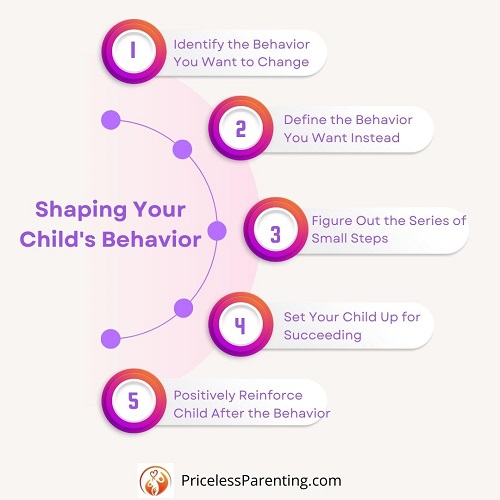Positively Transforming Your Kids’ Behavior Through Shaping
by Kathy Slattengren, M. Ed., Priceless Parenting (sign up for monthly parenting newsletter and receive 20+ printable charts for kids and parents)

Are there any of your kids’ behaviors that you would like to change? Perhaps you feel frustrated that your child won’t practice the piano without being nagged, doesn’t listen the first time, or is super slow in getting ready for school. By the time you are really bothered by a behavior, your child is probably well entrenched in behaving this way.
You may have resorted to yelling, threatening and taking away privileges to try to improve your child’s behavior. While that may have worked one day, you probably found you needed to yell louder, come up with bigger threats or take away more privileges to get your child to behave again.
What Researchers Have Discovered About Punishment
By the time frustrated parents turn to Dr. Alan Kazdin at the Yale Parenting Center they are at their wits end! He tells them
what he’s
learned from the research:
“Punishment - mild, severe, abusive - changes behavior only at the moment it is delivered. It doesn't change the overall level or rate of the behavior. So if you have a child who's doing something horrible and you smack them, it'll stop it for the moment but it won't decrease the number of times they do the horrible thing.
So there's an alternative. Decide what behavior you want, sometimes called the positive opposite, and praise or encourage that. That makes the negative behavior drop out. You can actually eliminate a behavior by rewarding or praising the opposite behavior. Punishment won't do it.”
Shaping the Behavior You Want
What does it mean to shape your child’s behavior? As Dr. Kazdin describes in his book,
The Kazdin Method for Parenting the Defiant Child, it involves five steps:
- Identify the Behavior You Want to Change
What is the behavior that you want to eliminate? Some examples are:
- Not wanting to practice the piano
- Refusing to eat vegetables
- Dragging his feet in getting ready for school
- Coming home later than expected
- Not listening the first time
- Define the Behavior You Want Instead
This is what Kazdin refers to as the “Positive Opposite”. What is the behavior you actually want? So for the examples above, the behaviors you want might be:
- Practicing the piano for 30 minutes daily
- Tasting one bite of the vegetables served
- Being ready for school 5 minutes before actually needing to leave
- Letting you know if he will be late
- Paying attention to your request and doing it the first time
- Figure Out the Series of Small Steps
Shaping your child’s behavior involves starting with your child’s current behavior and getting them to take a small step in the right direction. For example, if your child will typically sit at the piano for a minute, hit a couple keys and then leave, that’s the starting point. So the next small step might be sitting for two minutes and practicing one song the teacher has assigned.
If your child refuses to eat any vegetables, the first small step might be putting a bite of vegetable on a fork and touching it to his tongue without eating it. If your child is chronically late in getting ready for school, the first small step might be deciding what to wear the night before.
The idea is to start with one small step in the right direction and build from there. You are going to reward your child along every step of the way. While you may balk at rewarding your child for something you think they should already be able to do, it’s necessary if you want to change your child’s behavior.
- Set Your Child Up for Succeeding at the Behavior
This step involves everything that happens before your child’s behavior. For example, when you are making a request your child is more likely to comply if you are calm, smile, use “please” and a pleasant tone. Researchers have also found that being near a child is much more effective than shouting from across the room.
Another way to increase your child’s likelihood of cooperating is to make it a good natured challenge. For instance if your 3-year-old is refusing to get dressed you might say “You’re a little young to be dressing yourself so I will help you. Most kids can do this sometime before they turn four so you’ll be able to do it pretty soon.”
Your kids love your attention so this is another tool in shaping their behavior. For example, if your child doesn’t want to practice the piano, you might agree to sit down with your child while he practices.
You might also use a reward chart to acknowledge whenever your child does the behavior. Reward charts can be extremely effective at shaping the behavior you want. The reward chart is a temporary device for getting your child to focus on the behavior you want through earning small rewards.
For example, we used a reward chart when my son was potty training. There were 5 rows with 7 spaces. Each time he pooped in the toilet, he earned one star in a space. After a row was completed, he got a Matchbox car. After all the rows were completed, we had a “big boy” celebration at Chucky E Cheese’s! No more accidents – we were thrilled!
- Positively Reinforce Your Child After the Behavior
Everyone changes their behavior in response to feedback. The best reinforcement comes by doing it right after your child’s behavior, being specific, being enthusiastic and including positive touch. These simple actions will increase the likelihood that your child will repeat the behavior.
After your child successfully does the first small step, you change your response to rewarding the next small step. You keep leading your child one step at a time until they are able to do the final behavior. While the shaping process takes time, your reward is coming when your child achieves the final behavior you want!
About Kathy Slattengren

Parenting expert Kathy Slattengren, M. Ed., is dedicated to supporting parents in doing their best parenting. She helps families create
homes where everyone feels accepted, heard, respected and appreciated.
Parents and teachers from
across the United States to Australia have been helped through Priceless Parenting's:
coaching
online parenting classes
parenting articles
presentations
Raising Kids Who Blossom book